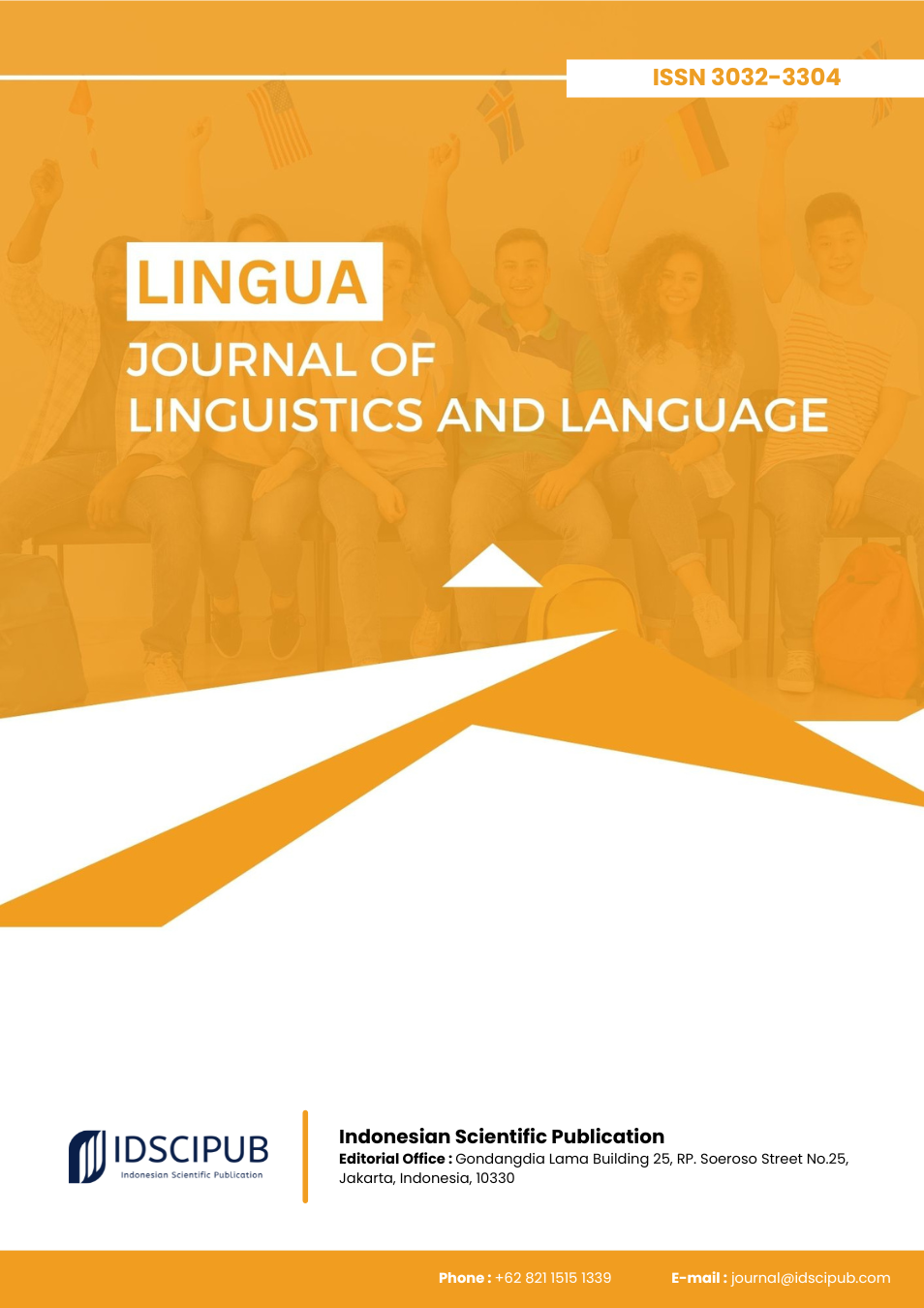Corpus Linguistics in Discourse Analysis: Toward Inclusive and Critical Frameworks
DOI:
https://doi.org/10.61978/lingua.v3i3.1036Keywords:
Corpus Linguistics, Discourse Analysis, Critical Discourse Studies, Digital Communication, Educational Applications, Migration Discourse, Socio-Cultural NarrativesAbstract
This study provides a comprehensive narrative review of the integration of corpus linguistics and discourse analysis, examining how methodological and contextual factors influence the field. The objective is to assess the role of corpus methodologies in enhancing discourse analysis while identifying key challenges and future directions. A systematic search of major databases including Scopus, PubMed, and Google Scholar was conducted using targeted keywords related to corpus linguistics and discourse analysis. Inclusion criteria prioritized peer-reviewed empirical and theoretical studies published in the last decade, while irrelevant and non-scholarly works were excluded. The analysis identified four major themes: technological integration, pedagogical applications, policy and institutional contexts, and socio-cultural influences. Results show that technological tools have greatly improved linguistic analysis, though regional disparities in access persist. Pedagogical applications demonstrate improved student outcomes, yet adoption varies across educational cultures. Policy frameworks were shown to shape discourse in areas such as migration and public health, while socio-cultural factors were found to be critical in constructing identities and narratives. The discussion highlights systemic barriers including funding inequalities and political restrictions, as well as opportunities for methodological innovation through integrated frameworks and collaborative research. The review concludes that advancing corpus linguistics in discourse analysis requires both methodological pluralism and systemic reform, with implications for education, policy, and global discourse studies.
References
Baider, F. and Kopytowska, M. (2017). Conceptualising the other: online discourses on the current refugee crisis in Cyprus and in Poland. Lodz Papers in Pragmatics, 13(2). https://doi.org/10.1515/lpp-2017-0011 DOI: https://doi.org/10.1515/lpp-2017-0011
Boginskaya, O. (2022). Functional categories of hedges: a diachronic study of Russian research article abstracts. Russian Journal of Linguistics, 26(3), 645-667. https://doi.org/10.22363/2687-0088-30017 DOI: https://doi.org/10.22363/2687-0088-30017
Brown, K. (2024). New opportunities for discourse studies. Journal of Language and Politics, 23(4), 473-495. https://doi.org/10.1075/jlp.23066.bro DOI: https://doi.org/10.1075/jlp.23066.bro
Cartron, A. (2023). A study of a specialised American police discourse genre: probable cause affidavits. Languages, 8(4), 259. https://doi.org/10.3390/languages8040259 DOI: https://doi.org/10.3390/languages8040259
Cheng, M. and Yu, Y. (2016). “We should…” versus “We will…”: how do the governments report their work in “one country two systems”? A corpus-driven critical discourse analysis of government work reports in Greater China. Text & Talk - An Interdisciplinary Journal of Language Discourse Communication Studies, 36(2). https://doi.org/10.1515/text-2016-0008 DOI: https://doi.org/10.1515/text-2016-0008
Elafropoulos, D. (2024). The COVID-19 pandemic in Greece through the lens of methodological synergy: combining corpus linguistics and critical discourse analysis approaches. Επιθεώρηση Κοινωνικών Ερευνών, 37-66. https://doi.org/10.12681/grsr.38498 DOI: https://doi.org/10.12681/grsr.38498
Freitas, H. (2023). Considerações sobre a base nacional comum curricular (BNCC) enquanto um gênero de governança. Calidoscópio, 21(2), 361-377. https://doi.org/10.4013/cld.2023.212.08 DOI: https://doi.org/10.4013/cld.2023.212.08
Friginal, E. (2024). Beyond expectations: (applied) corpus linguistics and a framework for the study of spoken professional talk. Ibérica, (47), 43-66. https://doi.org/10.17398/2340-2784.47.43 DOI: https://doi.org/10.17398/2340-2784.47.43
Haider, A. (2018). Using corpus linguistic techniques in (critical) discourse studies reduces but does not remove bias: evidence from an Arabic corpus about refugees. Poznan Studies in Contemporary Linguistics, 55(1), 89-133. https://doi.org/10.1515/psicl-2019-0004 DOI: https://doi.org/10.1515/psicl-2019-0004
Hobbs, V. (2019). The discourse of divorce in conservative Christian sermons. Critical Discourse Studies, 17(2), 193-210. https://doi.org/10.1080/17405904.2019.1665079 DOI: https://doi.org/10.1080/17405904.2019.1665079
Ismail, H., Baharun, H., Abdullah, H., & Majid, S. (2020). Power and voices of authority in the media narrative of Malaysian natives: combining corpus linguistics and discourse analysis approaches. 3L The Southeast Asian Journal of English Language Studies, 26(2), 50-66. https://doi.org/10.17576/3l-2020-2602-04 DOI: https://doi.org/10.17576/3L-2020-2602-04
Leung, C., Chow, M., & Ge, H. (2024). Compiling data for investigating language use in classroom discourse: a corpus-driven method. MethodsX, 13, 103048. https://doi.org/10.1016/j.mex.2024.103048 DOI: https://doi.org/10.1016/j.mex.2024.103048
Lin, A. (2014). Critical discourse analysis in applied linguistics: a methodological review. Annual Review of Applied Linguistics, 34, 213-232. https://doi.org/10.1017/s0267190514000087 DOI: https://doi.org/10.1017/S0267190514000087
Леврінц, М. (2024). Language teaching challenges through the lens of corpus linguistics. TEFLIN Journal - A Publication on the Teaching and Learning of English, 35(1), 40-65. https://doi.org/10.15639/teflinjournal.v35i1/40-65 DOI: https://doi.org/10.15639/teflinjournal.v35i1/40-65
Marchi, A. (2022). Corpus linguistics in the study of news media. In The Routledge Handbook of English Language and Digital Humanities (pp. 576-588). https://doi.org/10.4324/9780367076399-40 DOI: https://doi.org/10.4324/9780367076399-40
Ortiz, A. and García-Gámez, M. (2023). Strategies for the analysis of large social media corpora: sampling and keyword extraction methods. Corpus Pragmatics, 7(3), 241-265. https://doi.org/10.1007/s41701-023-00143-0 DOI: https://doi.org/10.1007/s41701-023-00143-0
Pérez, M. (2023). The representation of migration in parliamentary settings: critical cross-linguistics corpus-assisted discourse analyses. Humanities and Social Sciences Communications, 10(1). https://doi.org/10.1057/s41599-023-02496-y DOI: https://doi.org/10.1057/s41599-023-02496-y
Potts, A. and Semino, E. (2017). Healthcare professionals' online use of violence metaphors for care at the end of life in the US: a corpus-based comparison with the UK. Corpora, 12(1), 55-84. https://doi.org/10.3366/cor.2017.0109 DOI: https://doi.org/10.3366/cor.2017.0109
Rasulo, M. (2021). Are gold hoop earrings and a dab of red lipstick enough to get even Democrats on the offensive? Journal of Language Aggression and Conflict, 9(1), 155-183. https://doi.org/10.1075/jlac.00057.ras DOI: https://doi.org/10.1075/jlac.00057.ras
Richter, K., Gaskaree, B., & Mirzai, M. (2022). A functional analysis of lexical bundles in the discussion sections of applied linguistics research articles: a cross-paradigm study. Russian Journal of Linguistics, 26(3), 625-644. https://doi.org/10.22363/2687-0088-27752 DOI: https://doi.org/10.22363/2687-0088-27752
Romero-Barranco, J. and Rodríguez–Abruñeiras, P. (2021). Current trends in corpus linguistics and textual variation. Research in Corpus Linguistics, 9(2), i-xiii. https://doi.org/10.32714/ricl.09.02.01 DOI: https://doi.org/10.32714/ricl.09.02.01
Roshdy, R. (2024). Exploring the interface between corpus and statistical modelling: a multi-methodological analysis of lexical variation in Islamic legal discourse. JoSTrans, 42(42), 126-154. https://doi.org/10.26034/cm.jostrans.2024.5986 DOI: https://doi.org/10.26034/cm.jostrans.2024.5986
Serafis, D., Raimondo, C., Assimakopoulos, S., Greco, S., & Rocci, A. (2021). Argumentative dynamics in representations of migrants and refugees: evidence from the Italian press during the ‘refugee crisis’. Discourse & Communication, 15(5), 559-581. https://doi.org/10.1177/17504813211017706 DOI: https://doi.org/10.1177/17504813211017706
Wang, J. and Jin, G. (2023). Critical discourse studies eleven years on in China (from 2011 to 2021): a critical review. Discourse Studies, 25(3), 361-382. https://doi.org/10.1177/14614456231158519 DOI: https://doi.org/10.1177/14614456231158519
Zhang, J. (2022). The “Chinese Dream” as a discursive symbol. Chinese Semiotic Studies, 18(4), 605-631. https://doi.org/10.1515/css-2022-2082"} DOI: https://doi.org/10.1515/css-2022-2082






